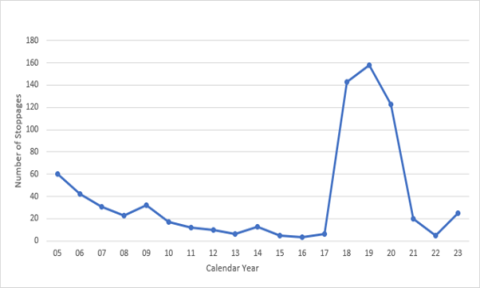Work stoppage information is used as an indicator of the state of industrial relations in New Zealand.
Work stoppages include strikes (action initiated by unions) and lockouts (action initiated by employers), compiled from the record of strike or lockout forms submitted to MBIE under section 98 of the Employment Relations Act 2000.
Work stoppage information focuses particularly on the economic impact of events such as strikes and lockouts, and does not cover forms of industrial unrest such as authorised stopwork meetings, strike notices, protest marches and public rallies.
Annual work stoppages
| Calendar year | Number of stoppages | Number of employees involved | Person-days of work lost | Estimated loss in wages and salaries $(million) |
|---|---|---|---|---|
| 2005 | 60 | 17,752 | 30,028 | 4.8 |
| 2006 | 42 | 10,079 | 27,983 | 5.2 |
| 2007 | 31 | 4,090 | 11,439 | 1.9 |
| 2008 | 23 | C | C | C |
| 2009 | 32 | 8,951 | 14,088 | 2.4 |
| 2010 | 17 | 6,394 | 6,285 | Unknown |
| 2011 | 10 | 14,102 | 14,887.5 | 2.54 |
| 2012 | 13 | 5,408 | 78,589 | 13.64 |
| 2013 | 6 | 312 | 16,219 | 0.12 |
| 2014 | 13 | 1,564 | 319,878.1 | 0.32 |
| 2015 | 6 | 2,528 | 35,882.8 | Unknown |
| 2016 | 3 | 434 | 24,005.6 | Unknown |
| 2017 | 6 | 421 | 73,412.4 | 0.07 |
| 2018 | 166 | 11,719 | 13,220 | 1.24 |
| 2019 | 143 | 44,030 | 70,037.5 | 4.93 |
| 2020 | 126 | 1,011 | 2,260.5 | 0.22 |
| 2021 | 20 | 308 | 336 | 0.03 |
| 2022 | 57 | 7,722 | 302,948 | 2.14 |
| 2023 | 25 | 53,448 | 53,448 | 11.53 |
| 2024 (as of 28 February) | 0 | 0 | 0 | 0 |
| C - confidential Source: Statistics New Zealand and MBIE |
||||
Number of work stoppages, 2005 to 2023

Available statistics
Please note that work stoppage data provided to MBIE may not be representative of complete work stoppage information:
- Under legislation, MBIE relies on employers to provide any or all of the relevant data through this process.
- Organisations with multiple offices who took action individually (eg different days or office locations) have been counted separately.
- Some of the notices only report on one or two people striking. However, not all strike notices include all data and employee numbers have been omitted where organisations have advised it is too difficult to count all staff who were involved in taking action.
- The count also includes partial strikes. For example, situations where employees perform their role but refuse to wear a uniform, or only carry out selected duties.
Work stoppages are classified by industry, institutional sector (private or public), region, cause, method of dispute resolution (how the dispute was resolved), and method of achieving a return to work.

